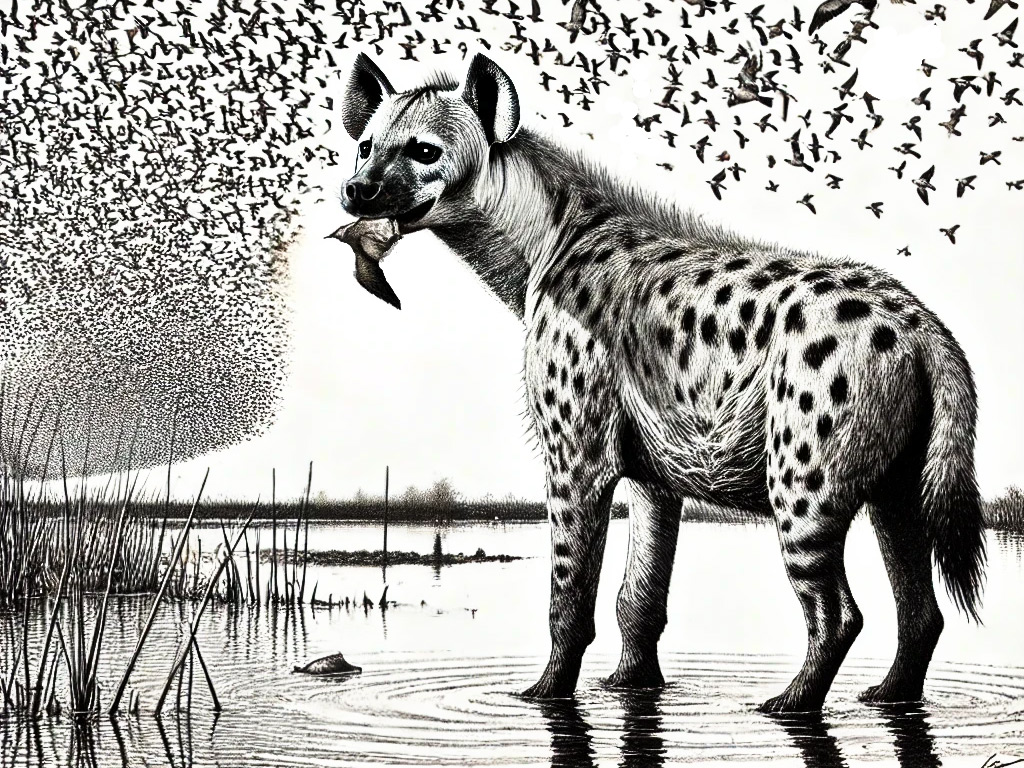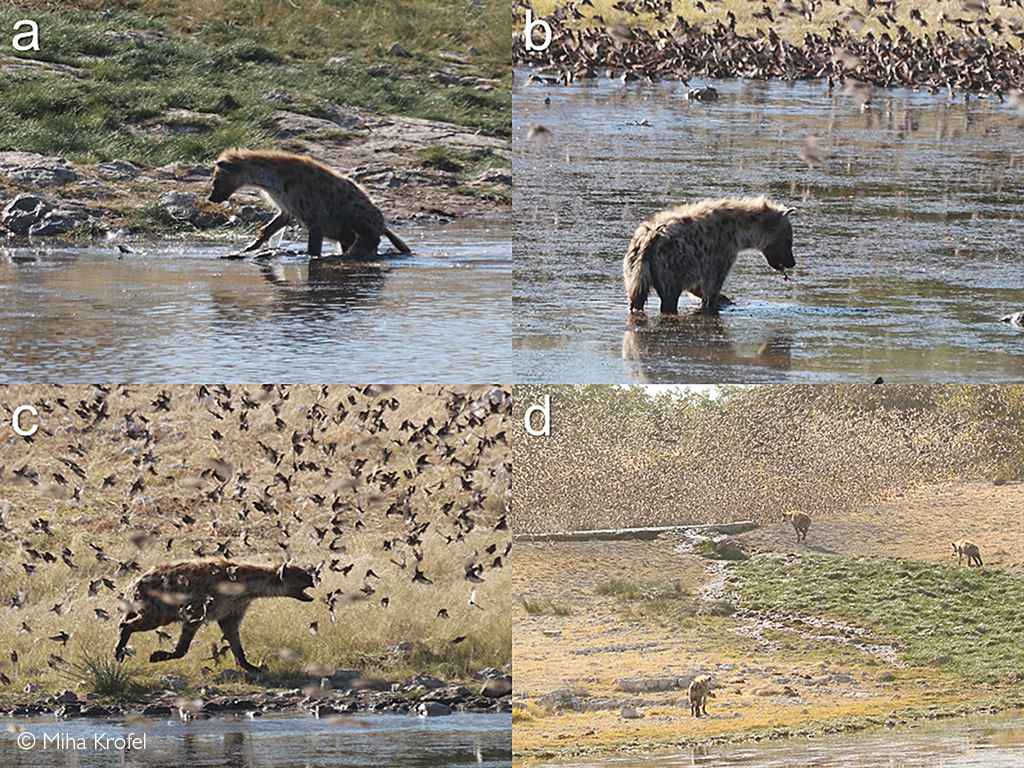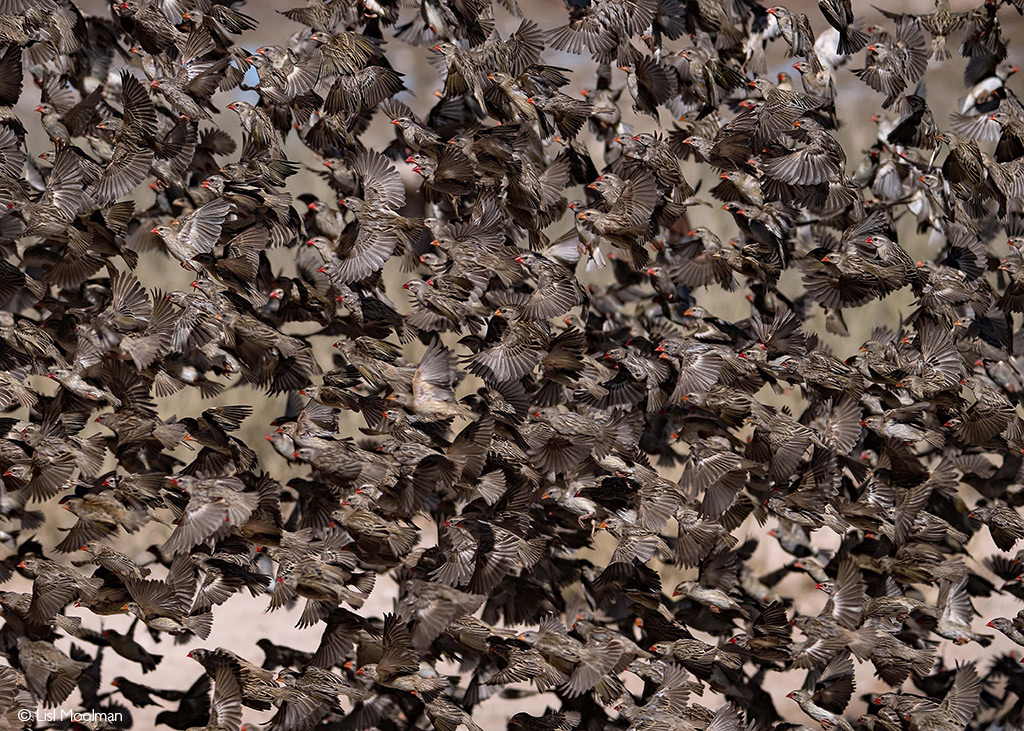
New research in Namibia’s Etosha National Park has uncovered an unexpected addition to the diet of spotted hyenas: red-billed queleas. These pint-sized passerines have become the latest item on the hyena menu. This discovery highlights hyenas’ opportunistic hunting tactics and their adaptability to exploit new food sources, showcasing their dietary flexibility and ecological resilience.
If you asked any naturalist about the diet of spotted hyenas, they would probably answer that hyenas are generalist scavengers that will devour anything left behind by other predators, and they would be correct. In addition, we know these resilient animals are also adept hunters, capable of taking down wildebeest and antelope if they have to.
However, recent studies in the Etosha National Park in Namibia showed an unexpected new addition to the diet of spotted hyenas: small birds. A team of researchers from the Leibniz Institute for Zoo and Wildlife Research in Germany and the University of Ljubljana in Slovenia were at a waterhole in Namibia’s Etosha National Park when they witnessed hyenas hunting tiny birds.
On two separate occasions, Ruben Portas and Dr Miha Krofel documented hyenas chasing and eating red-billed queleas. These small songbirds, part of the passerine order, are known for their flocking behaviour. Red-billed queleas often congregate in large numbers of a few thousand – and estimated flock sizes regularly exceed hundreds of thousands. Information on bird predation by spotted hyenas is rare, though they have been known to predate on large birds such as flamingos and ostriches. These latest findings, detailed and published in the scientific journal Food Webs, show that their diets may extend even further.

Portas and Krofel watched the hyenas chasing and grabbing flying queleas in flight, picking them up from the ground and the water’s surface and swallowing them whole. Through their observations, they estimated that an individual hyena was capable of catching approximately one bird every three minutes. They observed this at the Aus waterhole in Etosha. In total, four spotted hyenas participated in this behaviour.
The duo observed 38 successful captures, with an average individual capture rate of 3.5 birds per 10-minute period. Thousands of queleas flocked together to drink, and some would fall in the water or occasionally to the ground, potentially from colliding with other birds in the flock. In addition to grabbing the easy prey, the hyenas also grabbed birds from the air. Photographic and video evidence captured the unique predatory behaviour, representing the first documented accounts of spotted hyenas feeding on small passerine birds.


“It adds to the known variety of the spotted hyena diet and hunting tactics, since this behaviour has not been reported before,” said Portas. “It confirms their flexibility and ability to exploit foraging opportunities from unusual food sources.” Between May and August, thousands of red-billed queleas gather at Namibian waterholes during winter migration, providing an abundant potential food source, and hyenas seem to capitalise on this.
The observations took place on two different days in May 2022. The research team visited the same waterhole on three occasions in June but saw no hyenas or red-billed queleas. They also visited other waterholes during the study period, and while there were queleas present, no hyenas capitalised on the opportunity.
Since observations were limited to a single waterhole, it is possible that only some hyenas, or a specific group, exhibited the described foraging behaviour. This behaviour may have occurred as an opportunistic response to an abundant food source. It suggests hyenas can adapt their foraging strategy in response to an abundant food source, in this case the large quelea flocks congregating at Namibian watering holes in the autumn months.
Watch a video of the hyenas hunting below:
The researchers visit Etosha regularly to research predators like lion, leopard and hyena. They will continue to investigate carnivore-scavenger interactions and information transfer in the scavenger community in Etosha National Park. This long-term research aims to better understand species interactions and ecosystem functioning.
The ability to snack on small birds provides spotted hyenas with an opportunistic new protein source, adding nutritional variety to their diets. It remains to be seen if this is a learned behaviour of a single hyena clan or if it could be a widespread interaction across Africa, where red-billed queleas and hyenas co-occur.
Future studies might reveal whether this behaviour is unique to the Etosha hyenas or a broader adaptation among hyenas in regions overlapping with quelea populations. The discovery highlights the dynamic nature of predator-prey interactions and the importance of continuous observation to fully understand the complexities of wildlife ecology.


Further reading
A review of scientific literature on Hyaenidae reveals trends and gaps in the research on hyenas and other Hyaenidae species. Read more about the hiatus in the hyena literature here.
New research using camera traps has measured spotted hyena population density in southern Tanzania – the first study of its kind for Tanzania. Read more about spotting spotted hyena’s here.
High-ranking spotted hyena cubs inherit a social network of allies which increases access to resources & breeding opportunities. Read about how high society thrives amongst hyenas here.
Unravelling the elaborate sex lives of spotted hyenas: High-ranked male spotted hyenas are more reproductively successful than their low-ranked rivals – hormone and behaviour analysis reveals why.
Reference
Ruben Portas & Miha Krofel. Spotted hyena (Crocuta crocuta) predation on passerine birds in Namibia. Food Webs, Volume 38. 2024.
To comment on this story: Login (or sign up) to our app here - it's a troll-free safe place 🙂.![]()






